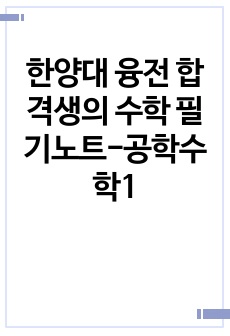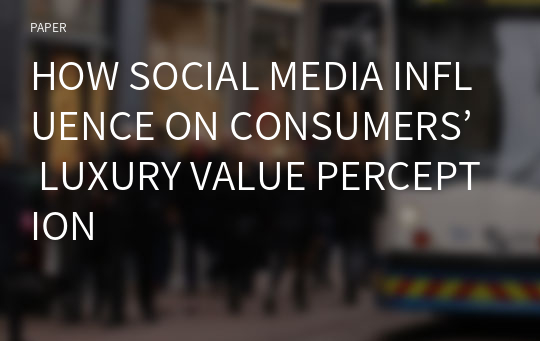HOW SOCIAL MEDIA INFLUENCE ON CONSUMERS’ LUXURY VALUE PERCEPTION
* 본 문서는 배포용으로 복사 및 편집이 불가합니다.
서지정보
ㆍ발행기관 : 글로벌지식마케팅경영학회(GFMC)
ㆍ수록지정보 : Global Marketing Conference
ㆍ저자명 : Bruno Godey, Jungsun Cho
ㆍ저자명 : Bruno Godey, Jungsun Cho
영어 초록
IntroductionLuxury industry, in addition to feelings, started to provide reasons for consumers to justify their consumption. Also, it helps them to avoid social risks by offering inconspicuous luxury products. For example, ‘Mandarin Oriental Barcelona’ suggests luxury holiday package for people running Barcelona marathon, London cocktail bar ‘Bart’ serves cocktails designed to 'facilitate focus and encourage relaxation', ‘Tiffany’ has dropped the spelled-out brand name from its fashion jewelry line in favor of simple “T”. (Trend watching 2017) Then, what changed consumers' interest? Interestingly, the current expectations of luxury consumers have a lot in common with the features of interdependent self-construal. The "we" effect of social media can explain this trend.
Literature review and Conceptual framework
Social Media usage and Interdependent Self-Construal Although earlier research in cultural psychology conceptualized self-construal as culturally determined (Markus and Kitayama 1991), more recent research suggests that independent and interdependent self-construal can also be made temporarily accessible. The most frequently adopted priming procedure to induce self-construal is the procedure by stories about we or I. (Gardner, Gabriel, and Lee 1999; Mandel 2003; Krishna, Zhou, and Zhang 2008; Hong and Chang 2015). We suggest that Social media usage can induce interdependent self-construal because social media users read stories and watch videos of others. Prior findings indicated that participants in interdependent self-construal condition have an equivalent number of thoughts about themselves and others. (Lee, Aaker, and Gardner 2000). Social Media, Interdependent Self-construal, and Consumers’ Luxury Value Perception Consumers’ perceptions of luxury value appear to be determined mainly by Functional, Individual, and Social aspects (Wiedmann, Hennigs, and Siebels 2009). Recent luxury marketing researchers compare conspicuous consumption and inconspicuous consumption, two types of social aspect consumption (Han, Nunes, and Dreze 2010; Eckhardt, Belk, and Wilson 2015). They are interested in Functional luxury value, added to Individual luxury value because small utilitarian additions to a hedonic luxury are often valued more than their stand-alone value (Keinan, Kivetz, & Netzer 2016). These two trends seem to have nothing in common. But when the concept of self-construal is adopted, they have something in common. Namely, interdependent selves, which focuses on others, are the one who cares about both inconspicuousness and utilitarian aspects. We suggest that because of the features of interdependent self-construal, consumers more using social media tend to have a different priority regarding luxury value perception than consumers less exposed to social media. We explore the mediating role of relational interdependent self-construal in this model (Triandis 1989; Cross, Bacon, and Morris 2000). Also, luxury brand company’s social media marketing efforts (Kim and Ko 2012; Godey et al. 2016) have different features. We expected that each social media marketing activity has a different impact on luxury value perception. Interdependent Self-Construal, Reason, Functional luxury value We propose that because of interdependence priming effect of social media, participants who are exposed to social media (social media priming group) tend to rely on both reason and feeling, which in turn set an equivalent value on Functional luxury value (cognitively superior) and Individual luxury value (affectively superior) (Hong and Chang 2015). Interdependent Self-Construal, Social Risk, Inconspicuousness The authors propose that because of interdependence priming effect of social media, participants who are exposed to social media (social media priming group) tend to avoid social risk than participants who are not exposed to social media (no priming group).
Study 1: The effect of social media on the balance between self and others.
A total of 709 respondents (389 females) participated in this study via Amazon Mechanical Turk (MTurk) They were randomly assigned to one of the two conditions (with social media manipulation vs. No manipulation) The impact of ‘one-time social media use’ Following the previous study (Hong and Chung 2015), we conducted a 2 (social media manipulation: No vs. Yes) x 2 (thought type: self vs other) mixed ANOVA with social media manipulation as a between-subject factor and thought type as a repeated measure. The main effect of thought type is significant (F(1,707) =293.54, p<.000). However, the interaction between social media manipulation and thought type was not significant. (F (1,707) = 0.128, p<.721). So, the result shows that one-time social media use doesn’t manipulate interdependent self-construal. The impacts of ‘chronic social media use’. To check whether chronic social media use can manipulate interdependent self-construal, we conducted a 2 (time spent on social media: Low vs. High) x 2 (thought type: self vs. other) mixed ANOVA. The main effect of thought type is significant (F(1,707) =293.81, p<.000). The interaction between time spent on social media and thought type was significant. (F (1,703) = 6.65, p<.000). Also, we conducted a 2 (communication on social media: Low vs. High) x 2 (thought type: self vs. other) mixed ANOVA. The main effect of thought type is significant (F(1,707) =300.76, p<.000). The interaction between communication and thought type was significant. (F (1,704) = 5.764, p<.000). So, the result shows that chronic social media use manipulates interdependent self-construal. Also, we computed three types of groups, the others-dominant, the balanced, and the self-dominant by modifying past research (Kitayama et al. 2009; Wu, Cutright, and Fitzsimos 2011, Hong and Chang2015). A chi-square test revealed that participants who spent more time and had more communication on social media had more balanced thought type (32.6%, 31.0%) than participants who spent less time and had less communication on social media (24.8%, 24.0%)
Study 2: The effect of using social media on luxury value perceptions (SEM)
A total of 255 respondents (85 females) participated in this study through Amazon Mechanical Turk (MTurk). The participants were between 18 and 65 years old and lived in the U.S., and the modal age group was 25-34 (43.9 %), followed by 35-44 (25.5%). We conducted exploratory factor analysis (EFA) using maximum likelihood estimation with Promax rotation. The goodness of fit statistics is:
참고 자료
없음"Global Marketing Conference"의 다른 논문
 THE ROLES OF GREEN PACKAGING IN UGLY FOOD PURCHASE INTE..22페이지
THE ROLES OF GREEN PACKAGING IN UGLY FOOD PURCHASE INTE..22페이지 THE IMPACT OF INDUCED AWE ON ETHICAL TOURIST BEHAVIORS5페이지
THE IMPACT OF INDUCED AWE ON ETHICAL TOURIST BEHAVIORS5페이지 A BIBLIOMETRIC ANALYSIS OF SPIRITUAL TOURISM RESEARCH15페이지
A BIBLIOMETRIC ANALYSIS OF SPIRITUAL TOURISM RESEARCH15페이지 SOCIAL NETWORK ANALYSIS AND RESPONSE TIME TESTING: CONS..11페이지
SOCIAL NETWORK ANALYSIS AND RESPONSE TIME TESTING: CONS..11페이지 THE EFFECTS OF PARA-SOCIAL INTERACTION ON ONLINE CELEBR..3페이지
THE EFFECTS OF PARA-SOCIAL INTERACTION ON ONLINE CELEBR..3페이지 THE INFLUENCE OF OPINION LEADERS ON DAILY DEALS USER’S ..3페이지
THE INFLUENCE OF OPINION LEADERS ON DAILY DEALS USER’S ..3페이지 HOW IMMERSIVE RETAILING AFFECTS CONSUMERS’ URGE TO BUY:..6페이지
HOW IMMERSIVE RETAILING AFFECTS CONSUMERS’ URGE TO BUY:..6페이지 KEY TO SUPERSTARDOM IN A GLOBALISED MARKET: THE ROLE OF..6페이지
KEY TO SUPERSTARDOM IN A GLOBALISED MARKET: THE ROLE OF..6페이지 A POST-PANDEMIC LOOK AT TOURISTS’ PERCEIVED COOLNESS OF..4페이지
A POST-PANDEMIC LOOK AT TOURISTS’ PERCEIVED COOLNESS OF..4페이지 EXTRACTING OFFLINE RETAIL SHOPPING PATTERNS: OLLABORATI..5페이지
EXTRACTING OFFLINE RETAIL SHOPPING PATTERNS: OLLABORATI..5페이지


























